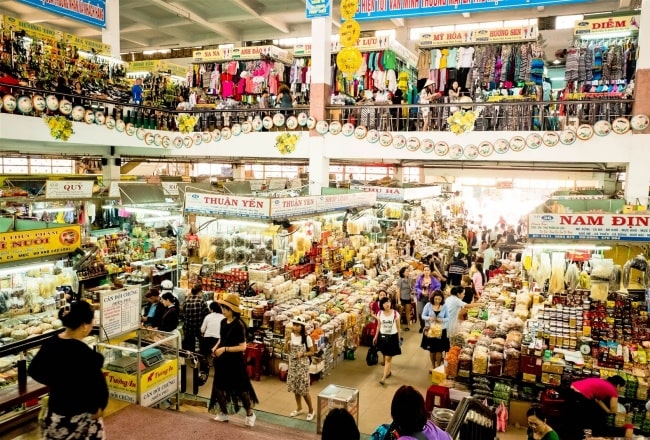Da Nang Weather Overview
Da Nang weather has a tropical monsoon climate, with mild temperatures throughout the year. A popular holiday destination among travellers, Da Nang has beautiful beaches such as My Khe Beach and Non Nuoc Beach. UNESCO-listed Hoi An and My Son Sanctuary are just a short drive away.
The city has two seasons every year. The wet period is from September until March, while the dry period is between April and August. Its close proximity to the South China Sea allows for average temperatures between 18°C and 34°C.
Check the below table to have the general idea of Da Nang weather throughout the year
| Month | Avg. High (°C) | Avg. Mean (°C) | Avg. Low (°C) |
|---|---|---|---|
| Jan | 24.4 | 21.2 | 18.6 |
| Feb | 26.6 | 22.8 | 19.9 |
| Mar | 28.4 | 24.6 | 21.7 |
| Apr | 31.1 | 26.8 | 23.5 |
| May | 34.1 | 28.8 | 25 |
| Jun | 35.2 | 30 | 25.9 |
| Jul | 34.6 | 29.4 | 25.3 |
| Aug | 34.1 | 29.1 | 25.2 |
| Sep | 32.2 | 27.7 | 24.2 |
| Oct | 29.7 | 26.1 | 23.1 |
| Nov | 27.9 | 24.8 | 22.2 |
| Dec | 25.5 | 22.4 | 19.9 |
Best time to go to Da Nang
February to May is the best time to visit Da Nang. This is the time when the rainfall level is not very high, making it comfortable for the visitors to enjoy their vacation. Da Nang has a tropical monsoon climate, with mild temperatures almost throughout the year.
The months with soaring temperatures are May to September. Right after this, rainfall season begins which lasts until January. The temperature is usually around 24-degree Celcius in May to September, and the rest of the year it is said to not go below 20-degree Celcius. December and January are also said to be an excellent time to visit Da Nang as the rainfall received are less as compared to the other months in the wet season. September to November is the worst time to visit Da Nang as it gets a substantial amount of rainfall at this time.
Da Nang Seasonal Weather Guide
That said, Da Nang has 2 main seasons: Dry season & wet season.
Dry season in Da Nang
The dry season in Da Nang occurs from January to September, and these months are hot and humid. The highest average temperature is around 33 to 35 degrees Celsius (91 to 95 degrees Fahrenheit) and the lowest is around 26 degrees Celsius (~79 degrees Fahrenheit). The hottest months of the year fall between June and August.
From January to March is when the weather is perfect. There isn’t much rain and the temperature fluctuates between 19.5 degrees to 27 degrees Celsius (~67 degrees – 80 degrees Fahrenheit). Hence, it is neither too hot and humid nor too cold and wet, which is fantastic. You can spend time doing all sorts of activities – from beaching to trekking, without feeling any extreme temperature. You will be joined by other tourists – foreign and locals alike that are keen to enjoy Da Nang during this time. The temperature continues to rise during April and May, and reaches the peak temperature during “summer” (from June to the end of August). The humidity also adds more discomfort to the situation.
What to wear during the dry season
Shorts and tank tops work well. Vietnam is not too conservative, but when you are going to temples, please be respectful and wear long sleeves. Sweaters are unnecessary but if you do plan on taking those long night buses, you may want one because they are literally moving refrigerators.
Travel tips for visiting Da Nang during the dry season
Here are some things you should remember when traveling to Da Nang during dry season:
- Stay hydrated: Don’t forget to buy a big bottle of water and carry it with you, especially if you are visiting Da Nang during the dry season. The heat and humidity will make you sweat a lot so you need to prevent dehydration. Make sure to eat well too, to make up for the lost vitamins.
- Apply sunscreen: Even if you want tan skin, you still need to put on sunscreen to protect your skin from the damaging effects of the sun. It can get pretty hot out there and we don’t want you to get sunburnt!
- Wear protective clothes: If you don’t want to get sunburned after five minutes of being outside, you really need long-sleeve shirts/jackets. Oh, and don’t forget a cap or hat for your hair. Sunglasses are a plus too!
- Bring a jacket: the weather during January to March is pretty cool. Sometimes the temperature can drop lower than 20 degrees Celsius (~68 degrees Fahrenheit), so you will need a jacket to keep you warm. It doesn’t have to be a thick winter coat but a suitable windbreaker or jumper will do.
- Book accommodation in advance: in peak season in Da Nang, it will be tricky to find a place to stay (especially during Da Nang International Fireworks Festival). I suggest you visit booking.com or Airbnb to reserve a room in advance.
Wet season in Da Nang
From October to March is when heavy rainfall occurs. At this time of the year, the rain will come frequently which makes the city much cooler. The average temperature is around 25.5 degrees Celsius (~78 degrees Fahrenheit) and the coolest months are November to January. Unfortunately, this time of the year is the typhoon season. There will be thunderstorms which could cause bad floods so you should check the weather forecast beforehand.
What to wear during the wet season
You don’t need winter coats, but jackets are very useful. A raincoat will also be great but you can buy disposable ones for less than 20,000 VND (almost 1 USD). The weather can still be stuffy during the day so bring a mix of short sleeves and long sleeves and you’re all set!
Travel tips for visiting Da Nang during the wet season
So, what should you know before traveling to Da Nang in the wet season?
- Carry a raincoat or travel-size umbrella: This is surely your bestie when traveling during rainy season. I bet you don’t want your cute outfit getting wet when a sudden downpour happens.
- Check the weather forecast: You should really check the weather forecast to plan your day (and your stay). The weather forecast apps on your iPhone are pretty accurate. If you are not a fan of Apple, you can still check the weather on weather.com or accuweather.com
- Have a plan B: Just in case it rains heavily for days or floods you should have a plan B in case your original plan doesn’t work out.
























































